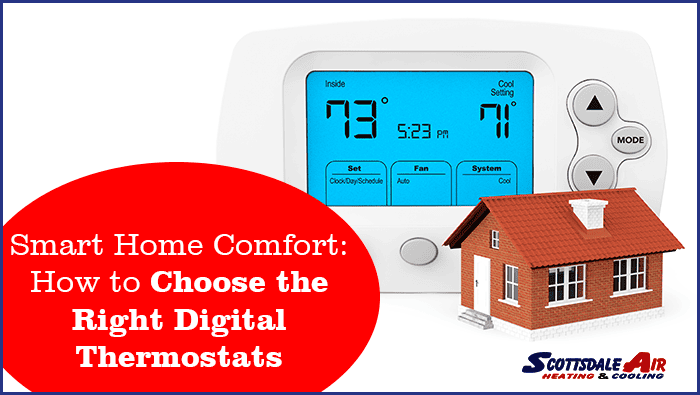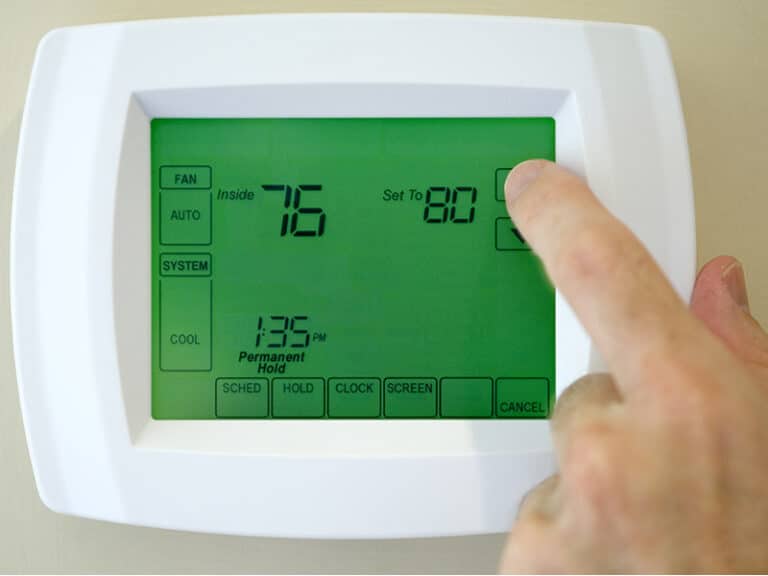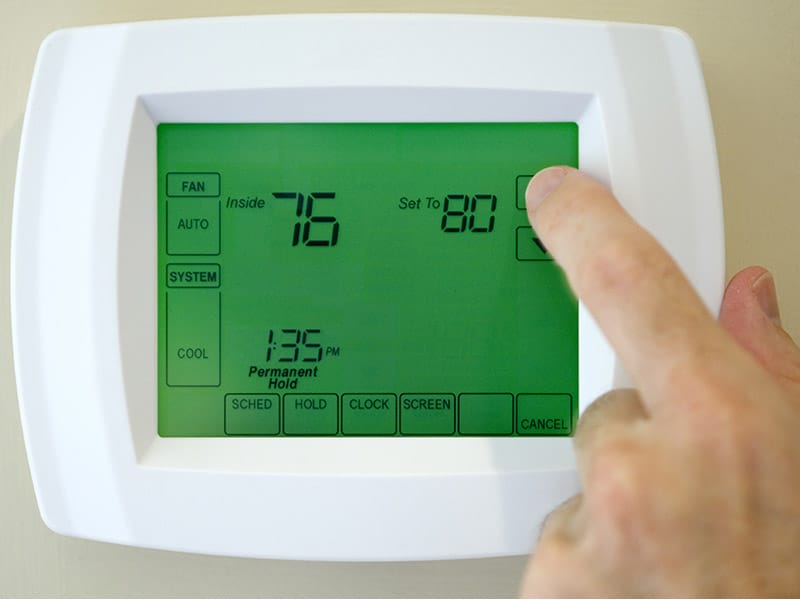Choose the right smart thermostat by considering compatibility with your HVAC system and desired features. Research energy-saving capabilities and user reviews.
Smart thermostats offer convenience, energy savings, and enhanced home comfort. They allow remote control via smartphones, optimizing heating and cooling schedules. Compatibility with your HVAC system is crucial to ensure seamless integration. Look for features like learning capabilities, geofencing, and voice control for added convenience.
Energy-saving functions can significantly reduce utility bills. User reviews provide insights into reliability and ease of use. Investing in a smart thermostat enhances home efficiency and comfort, making it a valuable addition to modern living spaces. Select a model that fits your needs and budget for the best experience.
Introduction To Smart Thermostats
Smart thermostats are revolutionizing home comfort. They offer advanced control over your home’s heating and cooling systems. With these devices, you can manage temperatures from your smartphone or other devices.
Smart thermostats not only make life easier but also help save energy and reduce utility bills. They learn your preferences and adjust settings automatically. This is a game-changer for modern households.
Rise Of Smart Home Technology
Smart home technology has grown rapidly. It includes devices like smart lights, locks, and thermostats.
These devices are interconnected, creating a seamless home experience. Smart thermostats are a key part of this ecosystem.
According to studies, homes with smart technology are more energy-efficient. They provide better control and convenience.
Benefits Of Smart Thermostats
Smart thermostats offer several benefits:
- Energy Savings: Smart thermostats help reduce energy consumption.
- Remote Access: Control your home’s temperature from anywhere.
- Learning Capability: These devices learn your schedule and preferences.
- Integration: They work with other smart home devices.
- Alerts and Reminders: Receive notifications for maintenance and issues.
These benefits make smart thermostats a valuable addition to any home. They enhance comfort, convenience, and energy efficiency.

Credit: scottsdaleair.com
Read More:
How to Change Old Thermostat to Smart Thermostat?: Easy Upgrade Guide
Key Features To Consider
Choosing the right smart thermostat can be tricky. Understanding key features helps. This guide simplifies the process. Focus on these crucial aspects.
Temperature Control Precision
Temperature control precision is essential. A smart thermostat with high precision keeps your home comfortable. Look for models that offer +/- 1-degree accuracy. Precise control saves energy and money. It ensures your home stays at the desired temperature.
Geofencing Capabilities
Geofencing capabilities add convenience. This feature uses your phone’s location. It adjusts the temperature when you leave or arrive home. Ensure your thermostat supports geofencing. This feature saves energy and enhances comfort. No more manual adjustments are needed.
Learning Algorithms
Learning algorithms make your thermostat smarter. It learns your habits and preferences. Over time, it adjusts settings automatically. This increases efficiency and comfort. Choose a thermostat with advanced learning algorithms. It simplifies home temperature management.
Compatibility Check
Choosing the right smart thermostat requires a careful Compatibility Check. This ensures your new device works seamlessly with your existing systems. Let’s delve into key compatibility factors.
Hvac System Suitability
Verify if the smart thermostat suits your HVAC system. Not all thermostats work with all HVAC setups. Check if your system is:
- Single-stage
- Multi-stage
- Heat pump
- Electric
- Gas
Consult the thermostat’s manual for detailed compatibility information. Ensure your HVAC setup matches the thermostat’s requirements.
Integration With Smart Home Ecosystems
Check if the smart thermostat integrates with your smart home ecosystem. Popular ecosystems include:
- Amazon Alexa
- Google Home
- Apple HomeKit
- Samsung SmartThings
Integration allows for voice control and automation. Verify if the thermostat supports your ecosystem. Look for compatibility badges on the packaging.
Here’s a quick reference table:
| Smart Thermostat | Amazon Alexa | Google Home | Apple HomeKit | Samsung SmartThings |
|---|---|---|---|---|
| Nest Learning Thermostat | ✔️ | ✔️ | ❌ | ✔️ |
| Ecobee SmartThermostat | ✔️ | ✔️ | ✔️ | ✔️ |
| Honeywell Home T9 | ✔️ | ✔️ | ❌ | ❌ |
Ensuring compatibility helps avoid setup issues. It also ensures smooth operation. Always double-check compatibility before purchase.
Energy Efficiency And Cost Savings
Choosing the right smart thermostat can lead to significant energy efficiency and cost savings. It’s essential to evaluate the potential reduction in energy bills and the investment return timeframe. This section will guide you through these critical factors.
Assessing Potential Reduction In Energy Bills
A smart thermostat helps reduce energy bills by optimizing heating and cooling. These devices learn your schedule and adjust temperatures automatically. This reduces unnecessary energy use when no one is home. Here are some key points:
- Learning Algorithms: Smart thermostats learn your habits and adjust accordingly.
- Remote Control: Control your thermostat from your phone, ensuring energy isn’t wasted.
- Energy Reports: Access detailed energy usage reports to understand your consumption.
| Feature | Energy Savings |
|---|---|
| Learning Algorithms | Up to 15% |
| Remote Control | Up to 10% |
| Energy Reports | Up to 5% |
Investment Return Timeframe
The initial cost of a smart thermostat can be higher than a regular thermostat. Yet, the cost savings on energy bills provide a good return on investment. Consider the following points:
- Initial Cost: Smart thermostats can range from $100 to $300.
- Average Savings: Savings can be around $130 to $150 per year.
- Payback Period: Typically, the payback period is 1 to 2 years.
It’s important to weigh the initial investment against the long-term savings. Smart thermostats not only save money but also contribute to a greener environment.
User Interface And Accessibility
Choosing the right smart thermostat involves understanding its user interface and accessibility. A well-designed interface ensures ease of use and enhances your experience.
Ease Of Use
A smart thermostat should be easy to operate. Look for intuitive design and clear instructions.
- Simple touchscreens
- Easy-to-read displays
- Clear icons and buttons
These features make navigating settings and schedules straightforward. A user-friendly design reduces the learning curve.
Remote Access And Control
Remote access is a key feature of smart thermostats. This allows you to control the temperature from anywhere.
| Feature | Benefits |
|---|---|
| Mobile App | Adjust settings on the go |
| Voice Control | Use voice commands for hands-free operation |
| Web Access | Control via a browser |
These features ensure you can manage your home’s climate easily. Choose a thermostat with strong remote access capabilities for better control.
Consider integration with smart home systems. Compatibility with devices like Alexa or Google Home enhances convenience.
In summary, the right smart thermostat offers a blend of ease of use and robust remote access.

Credit: totalcomfortal.com
Installation And Maintenance
Choosing the right smart thermostat doesn’t end with its features. The installation and maintenance process is equally important. This guide will help you navigate through the installation options and the ongoing upkeep of your smart thermostat.
Diy Vs. Professional Installation
Deciding between DIY installation and hiring a professional can be tricky. Let’s explore both options:
| DIY Installation | Professional Installation |
|---|---|
|
|
DIY installation is usually straightforward if you have basic skills. Most smart thermostats come with easy-to-follow guides. On the other hand, professional installation is ideal if your HVAC system is complicated.
Read More:
15 Best Smart Thermostats for Apartments: #2 Will Shock You
Ongoing Maintenance Requirements
Maintaining your smart thermostat ensures it runs efficiently. Here are some maintenance tips:
- Regularly clean the thermostat’s surface.
- Check and replace batteries as needed.
- Update the software for new features and security patches.
- Ensure the thermostat is free from dust and debris.
Some smart thermostats notify you about maintenance tasks. This feature helps you keep your device in top shape without much effort.
By understanding the installation and maintenance needs, you can make a more informed decision. This ensures your smart thermostat serves you well for years.
Security And Privacy Concerns
Choosing the right smart thermostat involves more than just features and price. Security and privacy are crucial aspects to consider. A smart thermostat connects to your home network. Therefore, it should be safe from hackers and protect your personal data.
Data Encryption And Protection
Data encryption ensures your information is safe from unauthorized access. A good smart thermostat uses advanced encryption methods. These methods include AES (Advanced Encryption Standard) and TLS (Transport Layer Security). Here is a table to summarize these encryption standards:
| Encryption Method | Description |
|---|---|
| AES | Encrypts data using a symmetric key algorithm. |
| TLS | Secures data transmitted over the internet. |
Firmware updates are also essential for data protection. Regular updates fix security flaws and keep your device secure.
User Privacy Policies
Read the user privacy policies before buying a smart thermostat. These policies explain how your data will be used and stored. Look for the following in a privacy policy:
- Data collection: What data is collected?
- Data usage: How is your data used?
- Data sharing: Is your data shared with third parties?
Privacy policies should be transparent and easy to understand. They should provide clear answers to the above points.
Consumer Reviews And Ratings
Choosing the right smart thermostat can be challenging. Consumer reviews and ratings can help. They provide insights from real users. This section will explore how to use reviews and ratings effectively.
Analyzing User Feedback
Reading user feedback is vital. It tells you the real story. Look for recurring comments. If many users mention the same issue, take note.
Positive Feedback:
- Easy to install
- Energy savings
- User-friendly interface
Negative Feedback:
- Connectivity issues
- Poor customer service
- Complicated setup
Pay attention to the number of reviews. A product with many reviews is more trustworthy. Check the dates of reviews. Recent reviews are more relevant.
Trusted Sources For Reviews
Not all review sites are equal. Some are more reliable than others. Here are some trusted sources:
| Source | Why It’s Trusted |
|---|---|
| Amazon | Large user base, verified purchases |
| Best Buy | Expert reviews, customer reviews |
| Consumer Reports | In-depth analysis, unbiased reviews |
| CNET | Expert reviews, detailed comparisons |
Check multiple sources. A product may have different ratings on different sites. Balance expert reviews with user feedback. Experts provide technical details. Users share real-life experiences.
By analyzing user feedback and trusting reliable sources, you can make an informed choice. Your perfect smart thermostat is out there.
Smart Thermostat Must-haves
Choosing the right smart thermostat can be challenging. With many options available, it is important to know what features to look for. This section will guide you through the must-have features for your smart thermostat.
Essential Vs. Additional Features
Smart thermostats come with a variety of features. Some are essential, while others are additional perks. Knowing the difference can help you make a wise choice.
| Essential Features | Additional Features |
|---|---|
|
|
Making A Checklist
Creating a checklist can simplify your decision-making process. List down essential features first, then add any additional features you want. Here’s a sample checklist:
- Wi-Fi Connectivity
- Programmable Schedules
- Energy Reports
- Compatibility with your HVAC system
- Voice Control (if desired)
- Geofencing (if desired)
- Smart Home Integration (if desired)
- Learning Capabilities (if desired)
Having this checklist ready will help you stay focused. It ensures you get a thermostat that meets your needs. Happy shopping!
Final Considerations Before Purchase
Choosing the right smart thermostat involves several steps. Before making a purchase, consider a few final aspects. These can help ensure the best choice for your home.
Warranty And Support
Check the warranty that comes with the smart thermostat. A good warranty can save you money in the long run. Most smart thermostats offer at least a one-year warranty. Some brands offer extended warranties.
Also, look at the customer support. Support can be crucial if you face issues. Look for brands with good reviews on customer service. Some companies provide 24/7 support. Others may offer support only during business hours.
Price Comparison And Deals
Compare prices from different retailers. Prices can vary significantly. Use online tools to compare prices easily. Look for seasonal sales and discounts. Sometimes, the best deals are available during holidays.
Also, check for rebates from energy companies. Some companies offer rebates for installing energy-saving devices. These rebates can lower the overall cost of your smart thermostat.
Here’s a simple table to help you compare:
| Brand | Price | Warranty | Support |
|---|---|---|---|
| Brand A | $199 | 2 Years | 24/7 Support |
| Brand B | $149 | 1 Year | Business Hours |
| Brand C | $179 | 3 Years | 24/7 Support |
Keep these final considerations in mind. This ensures you get the best smart thermostat for your needs.

Credit: totalcomfortal.com
Frequently Asked Questions
How Do You Know Which Smart Thermostat To Buy?
Check compatibility with your HVAC system. Look for energy-saving features. Read customer reviews. Compare prices and ease of installation. Ensure smart home integration.
How Do I Determine What Type Of Thermostat I Need?
Identify your HVAC system type, check compatibility, decide between programmable or smart, and consider additional features.
Can You Replace Any Thermostat With A Smart Thermostat?
Yes, you can replace most thermostats with a smart thermostat. Ensure compatibility with your HVAC system before purchasing.
What Are The Disadvantages Of A Smart Thermostat?
Smart thermostats can be expensive, require a stable internet connection, and may pose privacy concerns. They might also need professional installation and could be challenging for non-tech-savvy users.
Read More:
Sensi Touch Smart Thermostat Review: The Home Comfort Upgrade!
Conclusion
Choosing the right smart thermostat can save energy and enhance comfort. Consider features, compatibility, and ease of use. Research different models and read reviews. With the right choice, you’ll enjoy a more efficient and convenient home. Invest wisely in a smart thermostat for long-term benefits and peace of mind.




